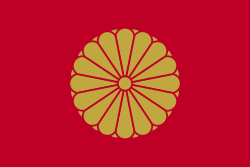Emperor Seinei
Emperor Seinei (清寧天皇, Seinei-tennō) was the 22nd Emperor of Japan,[2] according to the traditional order of succession.[3]
| Seinei | |
|---|---|
| Emperor of Japan | |
| Reign | 480–484 (traditional)[1] |
| Predecessor | Yūryaku |
| Successor | Kenzō possibly Iitoyo |
| Born | 444 |
| Died | 484 (aged 39–40) Iware no Mikakuri Palace |
| Burial | Kawachi no Sakado no hara no misasagi (河内坂門原陵) (Osaka) |
| House | Imperial House of Japan |
| Father | Emperor Yūryaku |
| Mother | Katsuragi no Karahime |
| Religion | Shinto |
No firm dates can be assigned to this Emperor's life or reign, but he is conventionally considered to have reigned from 480 to 484.[4]
Legendary narrative
Seinei was a 5th-century monarch.[5] The reign of Emperor Kinmei (c. 509 – 571 AD), the 29th Emperor,[6] is the first for which contemporary historiography is able to assign verifiable dates;[7] however, the conventionally accepted names and dates of the early Emperors were not to be confirmed as "traditional" until the reign of Emperor Kanmu (737–806), the 50th sovereign of the Yamato dynasty.[8]
According to Kojiki and Nihonshoki, he was a son of Emperor Yūryaku and his consort Katsuragi no Karahime. Seinei's full sister was Princess Takuhatahime. His name in birth was Shiraka (白髪皇子). It is said that the color of his hair was white since birth.[9] After the death of his father, Seinei won the fight against Prince Hoshikawa, his brother, for the throne and so succeeded his father.
Seinei's contemporary title would not have been tennō, as most historians believe this title was not introduced until the reigns of Emperor Tenmu and Empress Jitō. Rather, it was presumably Sumeramikoto or Amenoshita Shiroshimesu Ōkimi (治天下大王), meaning "the great king who rules all under heaven". Alternatively, Seinei might have been referred to as ヤマト大王/大君 or the "Great King of Yamato".
Seinei fathered no children; however, two grandsons of the 17th Emperor, Emperor Richū, were found—later to ascend as Prince Woke and Prince Oke. Seinei adopted them as his heirs.[10]
The actual site of Seinei's grave is not known.[2] The Emperor is traditionally venerated at a memorial Shinto shrine (misasagi) at Osaka.
The Imperial Household Agency designates this location as Seinei's mausoleum. It is formally named Kawachi no Sakado no hara no misasagi.[11]
See also
- Emperor of Japan
- Iitoyo (Empress Tsunuzashi)
- Imperial cult
Notes

- "Genealogy of the Emperors of Japan" at Kunaicho.go.jp; retrieved 2013-8-28.
- Imperial Household Agency (Kunaichō): 清寧天皇 (22); retrieved 2013-8-28.
- Titsingh, Isaac. (1834). Annales des empereurs du japon, pp. 28–29; Brown, Delmer M. (1979). Gukanshō, pp. 258–259; Varley, H. Paul. (1980). Jinnō Shōtōki, pp. 115–116.
- Ponsonby-Fane, Richard. (1959). The Imperial House of Japan, p. 41.
- Kelly, Charles F. "Kofun Culture," Japanese Archaeology. 27 April 2009.
- Titsingh, pp. 34–36; Brown, pp. 261–262; Varley, pp. 123–124.
- Hoye, Timothy. (1999). Japanese Politics: Fixed and Floating Worlds, p. 78; excerpt, "According to legend, the first Japanese Emperor was Jinmu. Along with the next 13 Emperors, Jinmu is not considered an actual, historical figure. Historically verifiable Emperors of Japan date from the early sixth century with Kinmei.
- Aston, William. (1896). Nihongi, pp. 109.
- Titsingh, p. 29; n.b., there is speculation that this unusual hair color suggests albinism.
- Aston, William. (1998). Nihongi, Vol. 1, pp. 373–377.
- Ponsonby-Fane, p. 419.
References
- Aston, William George. (1896). Nihongi: Chronicles of Japan from the Earliest Times to A.D. 697. London: Kegan Paul, Trench, Trubner. OCLC 448337491
- Brown, Delmer M. and Ichirō Ishida, eds. (1979). Gukanshō: The Future and the Past. Berkeley: University of California Press. ISBN 978-0-520-03460-0; OCLC 251325323
- Nippon Gakujutsu Shinkokai (1969). The Manyōshū: The Nippon Gakujutsu Shinkokai Translation of One Thousand Poems. New York: Columbia University Press. ISBN 0-231-08620-2
- Ponsonby-Fane, Richard Arthur Brabazon. (1959). The Imperial House of Japan. Kyoto: Ponsonby Memorial Society. OCLC 194887
- Titsingh, Isaac. (1834). Nihon Ōdai Ichiran; ou, Annales des empereurs du Japon. Paris: Royal Asiatic Society, Oriental Translation Fund of Great Britain and Ireland. OCLC 5850691
- Varley, H. Paul. (1980). Jinnō Shōtōki: A Chronicle of Gods and Sovereigns. New York: Columbia University Press. ISBN 978-0-231-04940-5; OCLC 59145842
External links
- Nihon Shoki Online English Translations. Scroll 15 – Emperors Seinei, Kenzo, and Ninken
| Regnal titles | ||
|---|---|---|
| Preceded by Emperor Yūryaku |
Emperor of Japan: Seinei 480–484 (traditional dates) |
Succeeded by Emperor Kenzō |
